| |
'Bring Back The King'
By Helen Pilcher
Book Review by Susan MacDougall
|
Author Helen Pilcher is uniquely qualified to explain the cutting-edge science that makes the resurrection of extinct animals a very real possibility, while acknowledging the serious and humorous aspects of giving a deceased animal a second chance to live.
If you could bring back to life a person or animal, what would you choose? Pilcher highlights her own choices from eras gone, including the King of the Dinosaurs, Tyrannosaurus rex, and the King of Rock 'n' Roll, Elvis Presley.
From dinosaurs to dodos and Neanderthals, BRING BACK THE KING reveals how the burgeoning field of DNA science is being used to help resurrect individual animals and entire species from their stony graves. Pilcher describes current initiatives and future plans to restore deceased animals, and uses both science and willful irreverence to assess the ramifications of how these genetic Lazaruses might fare in their brave new world.
EIN book reviewer Susan MacDougall explores this fascinating concept featured in this book... |
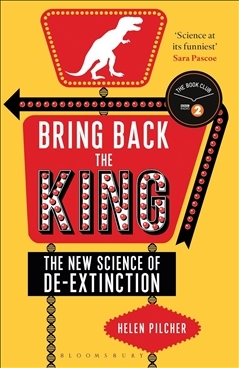 |
Susan MacDougall's review once again proving that EIN keeps a watch out for ELVIS featuring in nearly every serious and not-so-serious publication! |
Bring back the King: the new science of de-extinction, by Helen Pilcher. Bloomsbury Sigma, London, 2016. 280 pp. Bibliography, index.
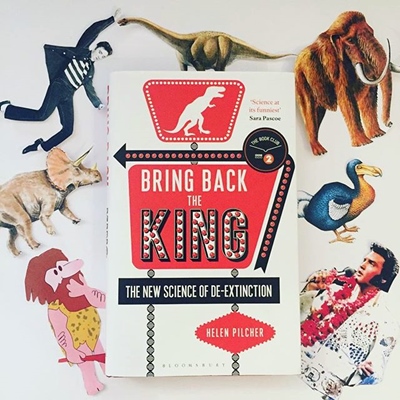 |
Genetic engineering is a hot topic now.
Would you want a Tyrannosaurus rex (T-rex) roaming the streets? Or a woolly mammoth? Would you want to meet Elvis Presley again? Is it feasible, possible, or desirable to bring them back? What about the habitat and food sources for any recreated ancient animals?
Helen Pilcher is well qualified to explain and discuss these issues. She is a cell biologist, science journalist and comedian, as well as an Elvis fan. Bring back the King discusses de-extinction – the science involved in resurrecting extinct species. Pilcher also addresses the conservation of, and assisted reproduction for, endangered species to keep them from extinction. There have been at least five mass extinctions in the history of the Earth. Whether we are aware of it or not, we are now in the midst of a sixth mass extermination, mainly brought about by human beings.
Bring back the King has chapters on various creatures Pilcher has selected as being possible candidates for de-extinction. They are: King of the Dinosaurs (Tyrannosaurus rex), King of the Cavemen (Neanderthals), King of the Ice Age (woolly mammoth), King of the Birds (dodo), King of Down Under (thylacine/Tasmanian tiger), and King of Rock ‘n’ Roll (Elvis Presley). Subsequent chapters cover practical, moral and ethical issues, progress to date and prospects for the future. Pilcher also writes about other extinct and nearly extinct animals.
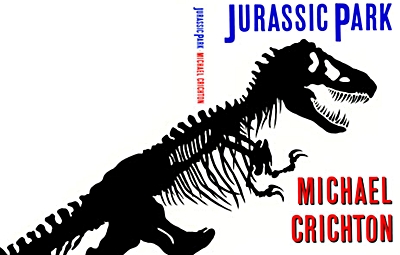 |
Jurassic Park
The idea of recreating long-gone creatures obviously intrigues people. In 1980 entomologist George Poinar discovered a fly trapped in amber with its DNA intact. His paper published in the journal Science attracted attention, and he joined the Extinct DNA Study Group. The Group speculated on de-extincting dinosaurs. Poinar was visited by a certain Michael Crichton, who asked about bringing back life forms in amber. Crichton used the scientific information they discussed as a basis for his novel Jurassic Park, published in 1990. This, in turn, was made into a very successful movie in 1993. Poinar is acknowledged in the back of the novel.
Candidates for De-extinction
Dinosaurs became extinct as a result of an asteroid strike. T-rex was not a slow, bumbling creature but a successful predator with rudimentary feathers rather than scales. The big obstacle to bringing dinosaurs back is finding DNA, which deteriorates over time.
Neanderthals disappeared 40,000 years ago. Judging from analysis of the shape of their skulls, they were no grunting savages. They had language and tools, were capable of camaraderie, compassion and deep social bonds. They cared for their sick community members. It’s possible to make a Neanderthal with today’s knowledge. However, DNA tests show that homo sapiens interbred with Neanderthals and that our DNA contains about 3% Neanderthal DNA. We have their genetic heritage within us, so there’s no need to bring them back!
The woolly mammoth disappeared about 10,000 years ago, possibly partly due to human hunting and climate change. They had ecological value. As vegetarians, they mowed the grass, fertilized the soil, and kept trees from overcrowding by trampling saplings, which resulted in fertile soil and diverse plant life. After they were gone, the land became unproductive mossy tundra.
The dodo was a large flightless pigeon that lived in Mauritius. It had no natural predators until Dutch ships arrived in 1598. Dodos were easy to kill and eat, although they apparently didn’t taste too good. The settlers wrecked their habitat by felling trees for sugar plantations. They flooded the island with rats, monkeys, pigs and goats. The dodo’s nests were destroyed and eggs and chicks predated. The search for dodo DNA goes on. Without its genome, there’s no hope of bringing it back. Truly “as dead as a dodo”, as Pilcher says.
The last thylacine died in Beaumaris Zoo, Hobart, in 1936 through neglect, starvation and dehydration. Its body was thrown out with the trash. The population was against thylacines because they were wrongly thought to kill sheep and children. A bounty was put on their heads and they were slaughtered in their thousands. Some DNA exists in the form of a thylacine pup pickled in a jar.
While they don’t have a chapter devoted to them, these creatures are also discussed: the gastric-brooding frog (which was wiped out by chytrid fungus), the African clawed frog, the Yangtze River dolphin (habitat destroyed), and the passenger pigeon (shot out of existence by hunters).
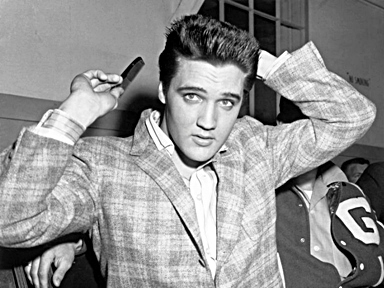 |
Bring back Elvis
The human race isn’t extinct, Elvis isn’t extinct. He’s just dead. So why the chapter on Elvis among chapters on extinct animals? It’s partly that Elvis fans may be interested in the idea of bringing Elvis back to life. In fact, there’s a web site called “Americans for Cloning Elvis” where you can join and sign a petition. It has, as its counterpart, “Americans for Cloning Dead Celebrities”, where you can nominate which celebrity you want brought back. Actually, human reproductive cloning is widely banned for legal, ethical and social reasons.
But Elvis is also an example of the issues around trying to clone an individual. While DNA produces a living being with exactly the same genes, it won’t create an exact replica of a specific person. Studies have been done on identical twins that prove the point.
Let’s start with the cloning process:
1) Find a source of Elvis’s DNA (probably a lock of hair)
2) decode his genome (complete set of DNA, including all of its genes)
3) edit the parts of Elvis’s genome that were unique to him into a regular human cell
4) transfer the cell into a human egg that has had its own DNA-containing nucleus removed
5) let the egg develop into an early-stage embryo in a test-tube or petri dish
6) implant the embryo into the womb of a surrogate mother.
The resulting baby would effectively be Elvis’s identical twin(!). However, this doesn’t mean that he is Elvis – or another Jesse Garon Presley. Pilcher calls him “GElvis” (Genetically engineered Elvis). Much has been said about “nature versus nurture”. In fact it’s more complicated than that. It’s environment, upbringing and epigenetics, ie, changes that affect the way genes work without altering the sequence of the DNA itself. So identical twins with identical DNA are not the same epigenetically. They do have the same genes but the way those genes are switched on and off is different.
What that means is that GElvis might not become a singer or entertainer or lead the same life. Pilcher points out that with the ever-increasing number of Elvis impersonators we don’t need GElvis. The real Elvis may not be with us physically and never can be again, but he’s still with us in spirit.
|
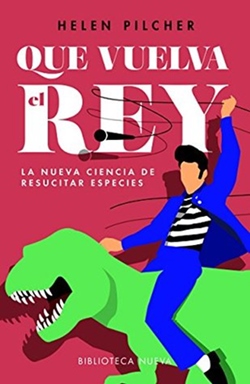 |
What animal would you de-extinct?
Actually, we aren’t limited to bringing back one extinct animal, but we should go slowly to start with. It will be experimental. There must be the right ecosystem and conditions for recreated animals to return to. There is also the issue of how they can be taught survival skills, such as how to recognize food, forage or hunt for it.
Scientists are preparing for the time when the technology is ready to go ahead with de-extinction. In northern-eastern Siberia, a scientist called Zimov is trying to recreate the woolly mammoth’s original ecosystem in a nature reserve called Pleistocene Park. Previously, cloning relied on collecting eggs and semen, which was often problematic (elephants being a prime example). The discovery that DNA could be extracted from skin was a significant breakthrough. Scientists have been collecting skin samples from rare and endangered animals for over 40 years, ready for the day when they will come in useful. The collection, called the Frozen Zoo, has more than 70,000 specimens from over 700 species of mammals, birds, reptiles, amphibians and fish.
When the time comes, it would be interesting to have a live T-rex to study, but too dangerous to have around. Pilcher’s preferred candidate is the northern white rhino. It’s not actually extinct: there are now only two left on Earth, and they are not in a physical state to reproduce.
Final Thoughts
You couldn’t call this light reading. There are various concepts to come to grips with. Although the techniques are described within the text, it would be useful to have a glossary of terms as an appendix for easy reference. However, Pilcher makes it interesting with her style and touches of humour. It’s “science for fun” for adults. Bring Back The King is a fact-packed, educational book, well worth the read.
Review by Susan MacDougall.
-Copyright EIN November 2018 - DO NOT COPY -
EIN Website content © Copyright the Elvis Information Network.
Comment on this review
Check out an interesting interview with author Helen Pilcher here on YouTube - She talks about cloning Elvis Presley 12 minutes in to the interview
GO HERE to SUSAN MACDOUGALL's EIN Book-Page to check out all her reviews
'They lost their heads! What happened to Washington’s teeth, (Elvis' wart) and other famous body parts' Book Review: Proving that EIN keeps a watch out for ELVIS in nearly every publication we start July 2018 with Susan MacDougall's review of 'They lost their heads! What happened to Washington’s teeth, Einstein’s brain, (Elvis' wart) and other famous body parts' by Carlyn Beccia.
The publicity notes that.. From the kidnapping of Einstein's brain to the horrifying end of Louis XIV's heart, the mysteries surrounding some of history's most famous body parts range from medical to macabre. Carlyn Beccia explores the misadventures of noteworthy body parts through history and springboards to exploring STEM topics such as forensics, DNA testing, brain science, organ donation, and cloning. The engaging tone, wonderfully creepy subject matter, and delightfully detailed art are sure to capture even the most reluctant readers.
So what has this to do with our Hero Elvis?
EIN book reviewer Susan MacDougall explores this weird book aimed at Children to check out whether Elvis will get a fair representation after all these years...
(Book Reviews, Source;Susan MacDougall/ElvisInformationNetwork) |
 |
'The Million Dollar Quartet’ Book Review: 'The Million Dollar Quartet’ is the name given to the impromptu jam session among Elvis Presley, Jerry Lee Lewis, Carl Perkins, and Johnny Cash on December 4th 1956.
This book by Stephen Miller - from 2013 - includes interviews with the drummer and the sound engineer.
It features a detailed analysis of the music played – and its relevance to subsequent popular music.
The early lives and careers of the quartet – where they were in 1956.
Relevant social and economic factors which meant that a massive audience of young people were keenly looking for a new kind of music they could call their own.
The “reunions” of surviving members of the quartet.
The emergence of the tapes, first on bootleg and then on legitimate CDs.
The genesis of the stage show and its reception – the enduring appeal of the music.
Go here as EIN book reviewer Susan MacDougall explores this detailed look into a jam session that Elvis fans all know so well... is there really any more to discover?
(Book Reviews, Source;SMacDougall/ElvisInformationNetwork)
|
 |
'The Seeker King' - Book Review: A woman in the audience once handed Elvis a crown saying, "You're the King." "No, honey," Elvis replied. "There is only one king -- Jesus Christ. I'm just a singer."
In his 2013 book 'The Seeker King: a spiritual biography of Elvis Presley' author Gary Tillery presents a coherent view of Elvis's thoughts through such anecdotes and other recorded facts. Elvis came to believe that the Christ shines in everyone and that God wanted him to use his light to uplift people. And so he did. Elvis's excesses were as legendary as his generosity, yet, despite his lethal reliance on drugs, he remained ever spiritually curious. This intimate, objective portrait inspires new admiration for the flawed but exceptional man who said, "All I want is to know and experience God. I'm a searcher, that's what I'm all about."
EIN book reviewer Susan MacDougall explores this interesting book and questions that since so much has been written about Elvis' including at least a dozen books about his spiritual search, is there anything new to say? Go here to read her detailed review to find out!
(Book Reviews, Source;SMacDougall/ElvisInformationNetwork)
|
 |
'The Death and Resurrection of Elvis Presley' - Book Review: Elvis Aaron Presley is more popular today than ever, yet he died nearly forty years ago. His music is constantly remixed and re-released to a new generation of fans, and his image thrives in popular art and culture. Elvis is the subject of some truly astonishing rumours and legends, including the one that he never actually died. In the new book, The Death and Resurrection of Elvis Presley, author Ted Harrison asks what lies behind the remarkable resurrection in popular culture of the King of Rock 'n' Roll. It tells the story of Elvis after Elvis. It shows how his estate, which was pillaged by his manager, was saved through the business acumen and financial vision of his ex-wife Priscilla Presley. It explores a spiritual dimension to the Elvis revival, where fans create a fantasy quasi-religion through which they blend and confuse Elvis and Jesus.
Published in 2016 this is a thoroughly researched book that brings us up-to-date with recent developments. Harrison draws on existing publications on the same topic, as well as websites and correspondence, conversations and interviews with many Elvis fans and associates conducted over 25 years, to make a well-argued case. He finally proposes possible future directions for this extraordinary Elvis phenomenon.
Go here as EIN book review Susan MacDougall explores this fascinating book and decides whether Elvis fans need to discover what the myth is all about.
(Book Reviews, Source;SMacDougall/ElvisInformationNetwork) |
 |
'Down At The End Of Lonely Street' - Book Review: This 1997 published fan favourite 'Down at the End of Lonely Street: The Life and Death of Elvis Presley'
promised an "intimate portrait of Elvis Presley, America’s favorite music idol, chronicling his remarkable life from a dirt-poor schoolboy in Memphis through his rise as a Rock n’ Roll superstar to his final days in Las Vegas. Drawing on exclusive interviews with Elvis’s closest friends and new documentary evidence, this biography reveals secrets about his relationships with his addictive mother Gladys, his ruthless manager Colonel Tom Parker, his musical rivals The Beatles, and the truth behind his marriage to Priscilla Beaulieu."
EIN reviewer Susan MacDougall checks out this old classic to see how it stands the test of time, look at some of the interesting issues addressed and investigates how the book sees Elvis as a "person" rather than an image.
(Book Review, Source: EIN, January 2016) |
 |
'Nashville Chrome' - Book Review: In the late fifties the Country Music group The Browns - Maxine, Bonnie, and Jim Ed - were enjoying unprecedented international success, rivaled only by their longtime friend Elvis Presley. The book 'Nashville Chrome' by author Rick Bass presents a vivid evocation of an era in American music, while at its heart it is a wrenching meditation on the complexities of fame and of one family who experienced them firsthand.
Just two months ago it was announced that The Browns would be inducted into Country Music Hall of Fame. With immaculate timing, EIN contributor Susan McDougall reviews the 2010 publication 'Nashville Chrome' about this fascinating group.
The connection between The Browns and Elvis is an intersting topic - and as always Susan presents both the positives and negatives about publishing a book about such a well-researched period.
Read Susan's full review
(Book Review, Source: EIN, May 2015) |
 |
EIN Website content © Copyright the Elvis Information Network.
Elvis Presley, Elvis and Graceland are trademarks of Elvis Presley Enterprises.
The Elvis Information Network has been running since 1986 and is an EPE officially recognised Elvis fan club.
.
. |
Did You Miss these Popular Interviews? |
| (Interview) Anne E. Nixon answers your questions |
| Ginger Alden Interview: |
| Elaine Beckett -Easy Come Easy Go costar- Interview: |
| Shirley Dieu, author of Memphis Mafia Princess, talks to EIN: |
| Interview With Elvis author - : Gillian G. Gaar |
| Interview with Dick Grob, Elvis' Head Of Security: |
| Interview with 'Elvis Films FAQ' author Paul Simpson: |
| Elvis Music FAQ - Mike Eder Interview: |
| "My Fast Life" Rare Elvis Presley 1964 Interview: |
| Linda and Sam Thompson in Australia: |
| John Wilkinson Tribute & 1972 Interview: |
| 'Elvis: Walk A Mile In My Shoes' - Arjan Deelen Interview: |
| RIP - Bernard Lansky talks to EIN: |
| Allyson Adams 'The Rebel and The King' Interview: |
| Joseph A. Tunzi |
| David Stanley (2012) |
| Vernon Presley Interview: |
| EIN interviews John Scheinfeld director of 'Fame & Fortune' |
| Jerry Leiber Interview for EIN |
| Elvis Paradise Hawaiian Interview - with Peter Noone |
| Sam Thompson, Elvis' bodyguard, 2011 Interview |
| James Burton Interview - Rick Nelson & Elvis: |
| Elvis Drummer Jerome "Stump" Monroe EIN Interview: |
| Donnie Sumner Remembers his friend Sherrill Nielsen: |
| Lamar Fike EIN Exclusive Interview |
| Jamie Aaron Kelley - EIN Interview: |
| Ernst Jorgensen interview about 'The Complete Masters' and more: |
| D.J Fontana Interview - Elvis Week 2010 special: |
| Red West Interview:- 2010 Elvis week special |
| Linda Thompson - Interview Special: |
| Elvis in 1969 - Ann Moses & Ray Connolly Interviews: |
| Ernst Jorgensen interview about 'On Stage' and Elvis' Legacy in 2010: |
| Paul Lichter |
| Dr. Nick talks to EIN |
| Alanna Nash |
| Ernst Jorgensen (2009) |
| Joseph Pirzada |
| Jeanne LeMay Dumas |
| Larry Geller |
| Mac Davis |
| Roger Semon |
| Ernst Jorgensen |
| Wayne Jackson (Memphis Horns) |
| |
Did You Miss these Popular EIN articles |
| 'Elvis Meets The Beatles': |
| Did Elvis Record 'Tiger Man' At Sun? |
| Forever Elvis - A 2015 commemorative Spotlight: |
| Elvis "Non Stop Erotic Cabaret": |
| 'Suppose - Did It Inspire Imagine': |
| EIN Spotlight on Aloha's director Marty Pasetta |
| FTD "What now, What next, What If? PART TWO ": |
| Elvis and the Coco Palms Resort: |
| Wertheimer's Reaction To Finding The 'Mystery Kisser': |
| UPDATED - 'Elvis Madison 1977 - The Gas Station Incident' with Kathy Westmoreland: |
| "If You're Going To Start A Rumble" -The Importance of Fights In Elvis Movies: |
| 'Big Boss Man: What Kind of Technical Advice Did Parker Provide for Elvis’s Movies?': |
| FTD - What now, What next, Where to – What’s left?: |
| JAZZWORLD - Music vs. Elvis Presley. |
| UPDATED - 'American Studios 1969 - A Turning Point In History': |
| 'ELVIS AT 21' Exhibtion |
| Elvis' Personal Record Collection: |
| 'The Nation's Favourite Elvis Song' Spotlight |
| Linda and Sam Thompson in Australia: |
| Fourteen Key Elvis Singles: |
| Happy Birthday EIN EIN turns 100 – a retrospective!: |
| Elvis Week Through The Years - Sanja Meegin looks back: |
| 'The Wedding' Elvis & Priscilla EIN special Spotlight: |
| John Lennon And Elvis: It was "Thirty Years Ago Today" |
| Elvis or Michael Jackson - who is the bigger star? |
| Dark Side of the Colonel |
| Elvis And The Vocal Group Tradition: |
| Aloha From Hawaii - The Concert 2013- EIN Exclusive |
| Elvis at Madison Square Garden 40 Years Ago |
| 'The Wedding' Elvis & Priscilla EIN special Spotlight: |
| 'Elvis In Ottawa' Spotlight & Elvis Interview: |
| "Kissed By Elvis" Janet Fulton Interview: |
| '1956, Elvis Presley’s Pivotal Year': |
| 'Elvis In Concert' 1977 TV special; Should it be released officially? |
| |
Did you miss these Reviews |
| (Book Review): CHANNELING ELVIS How Television Saved the King of Rock 'n' Roll: |
| (Book Review) Elvis and Ginger: |
| ‘Final Countdown To Midnight' jewel-case Versions Review: |
| 'Elvis Files Magazine ISSUE 8' Review: |
| (Book Review) Memphis Mafia Princess: |
| 'Final Countdown To Midnight' NYE 1976 - in-depth Review: |
| 'ELVIS' FTD Classic Album Review: |
| (Book Review) 100 Things Elvis Fans Should Know & Do Before They Die: |
| 'Elvis-The King Of The Jungle' In-Depth Book Review: |
| (Book Review): Elvis' Favorite Director: Norman Taurog: |
| 'ELVIS AT 21' Exhibition Review: |
| 'Elvis Music FAQ' - Book Review: |
| 'Elvis Films FAQ' Book Review: |
| 'The On Stage Season' FTD In-Depth Review: |
| 'The Elvis Files Vol. 6 1971-1973' Book Review: |
| 'Love Me Tender' Blu-Ray Edition Review: |
| 'Houston We Have A Problem' - CD review: |
| 'SOLD OUT' FTD CD Review: |
| ‘Elvis At Stax’ [Deluxe] Reviews: |
| ‘The King Revealed’ Magazine Review: |
| 'Hot August Night' FTD CD Review: |
| 'Elvis - Aloha Via Satellite: A 40th Anniv Release' Book Review: |
| 'The Elvis Files Vol. 1 1953-56' In Depth Book Review: |
| 'Aloha From Hawaii' 40th Anniv LEGACY CD Review: |
| Aloha From Hawaii - The Concert 2013- EIN Exclusive Review: |
| ‘Elvis On Tour’ E-book Review - with Great jumpsuit photos- |
| 'From Elvis Presley Boulevard' FTD In-Depth Review: |
| 'Prince From Another Planet’ In-Depth Review: |
| 'Elvis: Walk A Mile In My Shoes' - EIN Review: |
| ‘Greatest Live Hits of the 50s’ MRS CD Review: |
| Once Upon A Time: Elvis and Anita (Memories of My Mother) - Book Review: |
| 'A Boy From Tupelo' special In-depth Review: |
| Bootleg Elvis (Book Review) |
| 'G.I.Blues Vol.1' FTD Soundtrack - CD review: |
| 'From Hawaii to Las Vegas' FTD CD Review: |
| 'Elvis: Live at the International' Book Review: |
| 'The Complete Louisiana Hayride Archives 1954-1956’ Review: |
| '48 Hours To Memphis' FTD CD Review: |
| 'Young Man with the Big Beat' In-Depth Review: |
| 'Fashion For A King' FTD in-depth Review: |
| "ReBooked At The International'- in-depth Review: |
| 'Stage Rehearsal' FTD Review: |
| |
Audio-Visual |
| Best of Elvis on YouTube |
| Graceland cam |
| EPE's Multimedia Elvis Gallery |
| Sirius Elvis Satellite Radio |
| Elvis Radio (ETA's) |
| Elvis Express Radio |
| Ultimate Elvis Radio |
| Elvis Only Radio |
| "Images in Concert" PhotoDatabase |
| Radio Interview: Vernon & Gladys Presley |
| Sanja's Elvis Week 2007 Photo Gallery |
| 'EIN's Best of Elvis on YouTube' |
| The Music of Elvis Presley - Australian Radio Show |
|
Reference |
| All about Elvis |
| All about Elvis Tribute Artists |
| All about Graceland |
| All about Lisa Marie Presley |
| Ancestors of Elvis |
| Art Archives |
| Book Releases 2009 |
| Contact List |
| Elvis and Racism |
| Elvis as Religion |
| Elvis CDs in 2007 |
| Elvis DVDs in 2006 |
| Elvis Film Guide |
| '2007 New Releases' |
| Elvis Presley In Concert "downunder" 2006 |
| Elvis Online Virtual Library |
| Elvis Research Forum |
| Elvis Rules on Television |
| Graceland - The National Historic Landmark |
| How & where do I sell my Elvis collection? |
| Is Elvis the best selling artist? |
| Links to Elvis' family & friends |
| Links to other Elvis sites |
| Marty's Musings |
| Online Elvis Symposium |
| Parkes Elvis Festival 2009 (Australia) |
| Presley Law legal archives (Preslaw) |
| Presleys In The Press |
| Sale of EPE (Archives) |
| 6th Annual Elvis Website Survey |
| Spotlight on The King |
| "Wikipedia" Elvis biography |
| |
|
| |
|
|














